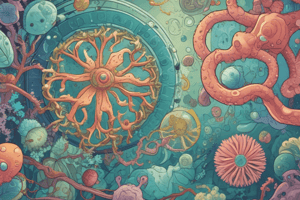Podcast
Questions and Answers
What is the primary characteristic that distinguishes bacteria from other microorganisms?
What is the primary characteristic that distinguishes bacteria from other microorganisms?
- Ability to undergo photosynthesis
- Presence of a true nucleus
- Peptidoglycan cell walls (correct)
- Autotrophic nutrition
Which type of microorganism is characterized by a protein coat surrounding genetic material?
Which type of microorganism is characterized by a protein coat surrounding genetic material?
- Viruses (correct)
- Bacteria
- Fungi
- Protists
What is the process of asexual reproduction in which a cell divides into two identical daughter cells?
What is the process of asexual reproduction in which a cell divides into two identical daughter cells?
- Mitosis
- Binary fission (correct)
- Symbiotic reproduction
- Meiosis
What is the term for microorganisms that obtain energy by consuming other organisms or organic matter?
What is the term for microorganisms that obtain energy by consuming other organisms or organic matter?
What is the term for the study of microorganisms in their natural environments?
What is the term for the study of microorganisms in their natural environments?
What is the term for a symbiotic relationship in which one organism benefits and the other is harmed?
What is the term for a symbiotic relationship in which one organism benefits and the other is harmed?
What is the application of microbiology in developing treatments and vaccines?
What is the application of microbiology in developing treatments and vaccines?
What is the term for the complex interactions between microorganisms in a shared environment?
What is the term for the complex interactions between microorganisms in a shared environment?
Flashcards are hidden until you start studying
Study Notes
Microbiology
Definition
- The study of microorganisms, including bacteria, viruses, fungi, and protists
- Microorganisms are typically microscopic, with sizes ranging from 0.1 to 5.0 μm
Types of Microorganisms
- Bacteria: prokaryotic cells, lacking a true nucleus, with peptidoglycan cell walls
- Examples: E. coli, Staphylococcus aureus
- Viruses: infectious particles composed of genetic material (DNA or RNA) surrounded by a protein coat
- Examples: influenza, HIV
- Fungi: eukaryotic cells, with a true nucleus, and chitin cell walls
- Examples: yeast, molds, mushrooms
- Protists: eukaryotic cells, with a true nucleus, that do not fit into other kingdoms
- Examples: protozoa, algae, slime molds
Microbial Growth and Reproduction
- Binary fission: a process of asexual reproduction, where a cell divides into two identical daughter cells
- Nutrition: microorganisms obtain energy and nutrients through various mechanisms, including:
- Autotrophy: producing energy through photosynthesis or chemosynthesis
- Heterotrophy: obtaining energy by consuming other organisms or organic matter
Microbial Interactions and Ecology
- Symbiotic relationships:
- Mutualism: both organisms benefit
- Commensalism: one organism benefits, the other is unaffected
- Parasitism: one organism benefits, the other is harmed
- Microbial communities: complex interactions between microorganisms in a shared environment
- Microbial ecology: the study of microorganisms in their natural environments
Applications of Microbiology
- Medicine: understanding microorganisms to develop treatments and vaccines
- Food and beverage industry: using microorganisms in fermentation and preservation
- Environmental science: studying microorganisms to understand and mitigate environmental issues
Microbiology
Definition
- Microbiology is the study of microorganisms, including bacteria, viruses, fungi, and protists
- Microorganisms are microscopic, ranging from 0.1 to 5.0 μm in size
Types of Microorganisms
Bacteria
- Prokaryotic cells, lacking a true nucleus
- Peptidoglycan cell walls
- Examples: E. coli, Staphylococcus aureus
Viruses
- Infectious particles composed of genetic material (DNA or RNA) surrounded by a protein coat
- Examples: influenza, HIV
Fungi
- Eukaryotic cells, with a true nucleus
- Chitin cell walls
- Examples: yeast, molds, mushrooms
Protists
- Eukaryotic cells, with a true nucleus
- Do not fit into other kingdoms
- Examples: protozoa, algae, slime molds
Microbial Growth and Reproduction
- Binary fission: a process of asexual reproduction, where a cell divides into two identical daughter cells
- Nutrition: microorganisms obtain energy and nutrients through various mechanisms
Autotrophy
- Producing energy through photosynthesis or chemosynthesis
Heterotrophy
- Obtaining energy by consuming other organisms or organic matter
Microbial Interactions and Ecology
Symbiotic Relationships
- Mutualism: both organisms benefit
- Commensalism: one organism benefits, the other is unaffected
- Parasitism: one organism benefits, the other is harmed
Microbial Communities
- Complex interactions between microorganisms in a shared environment
Microbial Ecology
- The study of microorganisms in their natural environments
Applications of Microbiology
Medicine
- Understanding microorganisms to develop treatments and vaccines
Food and Beverage Industry
- Using microorganisms in fermentation and preservation
Environmental Science
- Studying microorganisms to understand and mitigate environmental issues
Studying That Suits You
Use AI to generate personalized quizzes and flashcards to suit your learning preferences.




